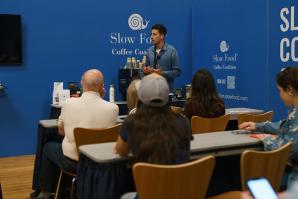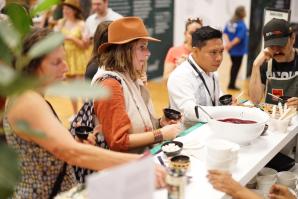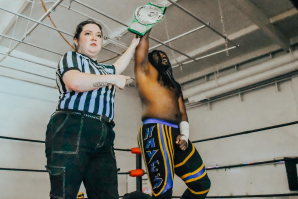Heads up, guitar geeks and music freaks: A Sacramento museum has gone a little bit rock ‘n’ roll — at least for the summer.
“America at the Crossroads: The Guitar and a Changing Nation,” a traveling exhibition from the National Guitar Museum, is at the California Museum through Sept. 1. The exhibit, which ties the evolution of guitars to American history, features 40 instruments, 10 video displays and more. An additional 18 guitars were acquired by the museum, located at 10th & O Streets, to spotlight California guitar manufacturers including Fender, Taylor, Alembic and Santa Cruz Guitar Company.
“California has so many great and innovative guitar companies, and we really wanted to focus on them,” says California Museum exhibitions director Amanda Sanchez. The Santa Cruz portion provides a portal into the craft of guitar-making, including a workbench, tools and pieces of guitars.
Music exhibits are uncommon in the museum world, and that’s part of the draw. The California Museum once did a rock concert poster exhibit, Sanchez says, but they’ve never done anything quite like this.
The California Museum acquired guitars by the California
manufacturer Alembic to add to the touring exhibit.

“A lot of our exhibits focus on heavier topics, like civil rights,” Sanchez says. “I thought this would be a fun summer exhibit, and also might attract another type of audience to the museum.”
Guitars have a multi-generational appeal and bring people to museums who might not normally go, says HP Newquist, executive director of the National Guitar Museum, which has no permanent home but several touring exhibits. “People are drawn in by the idea of guitars and pop culture and music,” he says. “Everybody knows somebody who plays guitar, or they play themselves, or they have family who plays.”
More than just providing eye candy — though there’s plenty of that — the intent of “America at the Crossroads,” Newquist says, is to trace American history through an accessible icon, the guitar.
“The idea is that you can track a huge amount, if not all, of American history through major events and major cultural cycles using the guitar as a representative icon,” he says. “Guitars have been here from the start of the New World.”
Exhibit-goers will find themselves walking through a timeline of guitars and related historical events, from the vihuela, a lute-like instrument brought by early Spanish colonists, to the wildly diverse array of guitars being made and played today. Guitars used in blues, jazz, country, early rock, hard rock, surf rock, punk rock — along with film clips of famous musicians playing them — it’s all here. There are drop-dead gorgeous guitars (the Gretsch White Falcon, nicknamed the Cadillac of Guitars, comes to mind), space-age guitars (including the Gibson Flying V) and crazy hybrids such as the Harp Guitar, also a Gibson.
There’s even an Air Guitar — an empty case with nothing but a caption describing the sport of playing an imaginary guitar, which blew up in the ’70s and ’80s. “You’ve gotta have some humor,” Newquist says. It’s been a crowd favorite, he adds, at other host museums.
Heavy attention is paid to the iconic Fender Stratocaster (“Strat”), the most recognizable electric guitar in pop culture, famously played by everyone from Buddy Holly to Jimi Hendrix. If you’ve seen footage of Hendrix setting a guitar ablaze at the 1967 Monterey Pop Festival, you’ll recognize a replica of that very guitar, a white Strat with a multicolored psychedelic design, in the “Touring California” case.
That case is one of the exhibit’s most popular, says Sanchez, because of all the big names in it including Eddie Van Halen, John Lee Hooker and Kurt Cobain. “I really loved Nirvana, and I thought, ‘There has to be a way to get Kurt Cobain’s guitar in there,’” says Sanchez, who paired Cobain’s black-and-white Strat with a poster from Nirvana’s 1993 Oakland Coliseum concert, part of their “In Utero” tour.
Elsewhere in the exhibit is a gleaming black Gibson ES-355 (“Lucille”) signed by B.B. King, given to the National Guitar Museum after they honored the blues giant with a Lifetime Achievement Award.
But of all the guitars in the room, it was the bright green Ibanez JEM that stopped Scott Gregory in his tracks.
“Ooh,” said Gregory, his eyes lighting up as he inched closer to the display case. “That’s the one I lust after.” As a lifelong guitarist and performer in local bands for 40-plus years, Gregory has pretty much seen it all, six-string wise. But the JEM really grabbed him, and for one simple reason: It was designed by guitar legend Steve Vai, one of his all-time favorites.
As a bona fide guitar geek — he also works part-time as a guitar tech and repairman at Skip’s Music — Gregory’s take on the exhibit is more finely tuned than most. For starters, he could’ve written most of the museum placards himself. He’s that knowledgeable.
In fact, Gregory could only single out one guitar in the bunch he’d never seen: Visionary Instruments’ TeleVision, shaped like a Fender Telecaster, with a full color video screen built into its body. “That’s an unusual one,” he said, peering quizzically at the oddball instrument.
The iconic Fender guitar company was founded in Fullerton,
California in 1946.

Though that was the only real surprise he encountered, Gregory found the exhibit worth a spin. “As a guitar guy, it was worth the trip,” he says. “There were definitely some very interesting pieces and displays.”
We both appreciated the small but important “Women” display, featuring a video loop of famous female guitarists including Bonnie Raitt, Nancy Wilson (of Heart) and Chrissie Hynde. “At Skip’s (Music), we’re seeing the female demographic of guitar players enlarge, and at all ages,” Gregory says. “There’s even one 70-something-looking woman who comes in every week for her lesson.”
We agreed our only slight disappointment was that most of the videos, including that one, had the sound turned off. (I even tried twisting knobs.) “Music is an audio format,” as Gregory says.
Sanchez says the museum opted to provide sound on only a few videos at a time (I counted three) due to space limitations. “I’m sure it works better in gallery spaces that are more open,” she says. “In this space, having them all on at once would be sensory overload.”
One of the best things about the exhibit, Sanchez says, is that you don’t need to be a “guitar person” to enjoy it.
“I can’t play guitar to save my life,” she says, with a slight laugh. “But I think most visitors will appreciate the creativity and the craftsmanship of the guitars, and I think it will appeal to all ages. Even young kids know what an electric guitar looks like, what a Stratocaster looks like, from music videos or watching TV.”
Beyond being wowed by cool guitars, Newquist says, he hopes exhibit-goers will learn something new.
“We want people to walk away at least having said ‘I didn’t know that, but now I do,’” he says.
“America at the Crossroads: The Guitar and a Changing Nation” is at the California Museum, 1010 O Street in Sacramento, through September 1. For more information, visit CaliforniaMuseum.org. To learn more about the National Guitar Museum, visit nationalguitarmuseum.com.
–
Subscribe to the Comstock’s newsletter today.
Recommended For You

Tower Bridge Dinner Chefs Announced
A diverse group will lead the 11th year of the Farm-to-Fork event
It’s one of the most anticipated announcements of the year for Sacramento’s culinary crowd — who will be the chefs for the 2024 Tower Bridge Dinner?

Sacramento Goes Global With New Food Conference
Terra Madre has potential to shine a ‘huge culinary spotlight’ on the city
Sacramento will serve as the site of a prestigious international food conference that could eventually bring thousands of tourists and millions of dollars into the region.

Vino Madre
Juicy scenes from the wine tasting room at the first Terra Madre Americas
For three days in May, the floor of the Memorial Auditorium was transformed into a global foodways classroom where one could sample coffee from Honduras, eat a cookie made from Bolivian quinoa and spin an oversized wheel that directed you to pithy sayings by food journalist Michael Pollan.

The Thrill of the Ring
Sacramento’s small-town professional wrestling scene is just as colorful as the big league
The alley entrance of a warehouse behind the Broadway Taco Bell on a recent Saturday was a portal to another world. A world of drama, where fans chanted and booed lustily, the air redolent of masculine funk.

Crafting in a Crowded Market
Crafting surged during the pandemic. But can Sacramento’s maker community find buyers?
The number of craft sellers on Etsy.com tripled after 2020. We checked in with the veterans and the newbies in the Capital Region’s crafting scene.

The Canned Craze
Canned cocktails and wines are light and easy to tote, perfect for a backyard barbecue, summer concert, picnic or anytime
The canned alcohol trend isn’t hard to spot. Just stroll through your local grocery store and you’ll see those colorfully packaged cans of prosecco and prickly pear margaritas all dressed up and ready to go, perfect for a picnic or poolside party.



